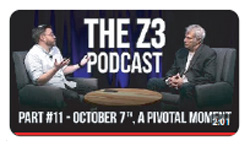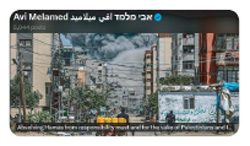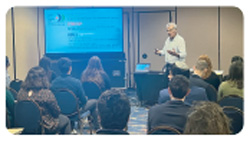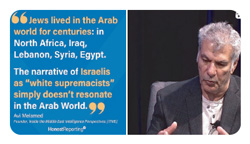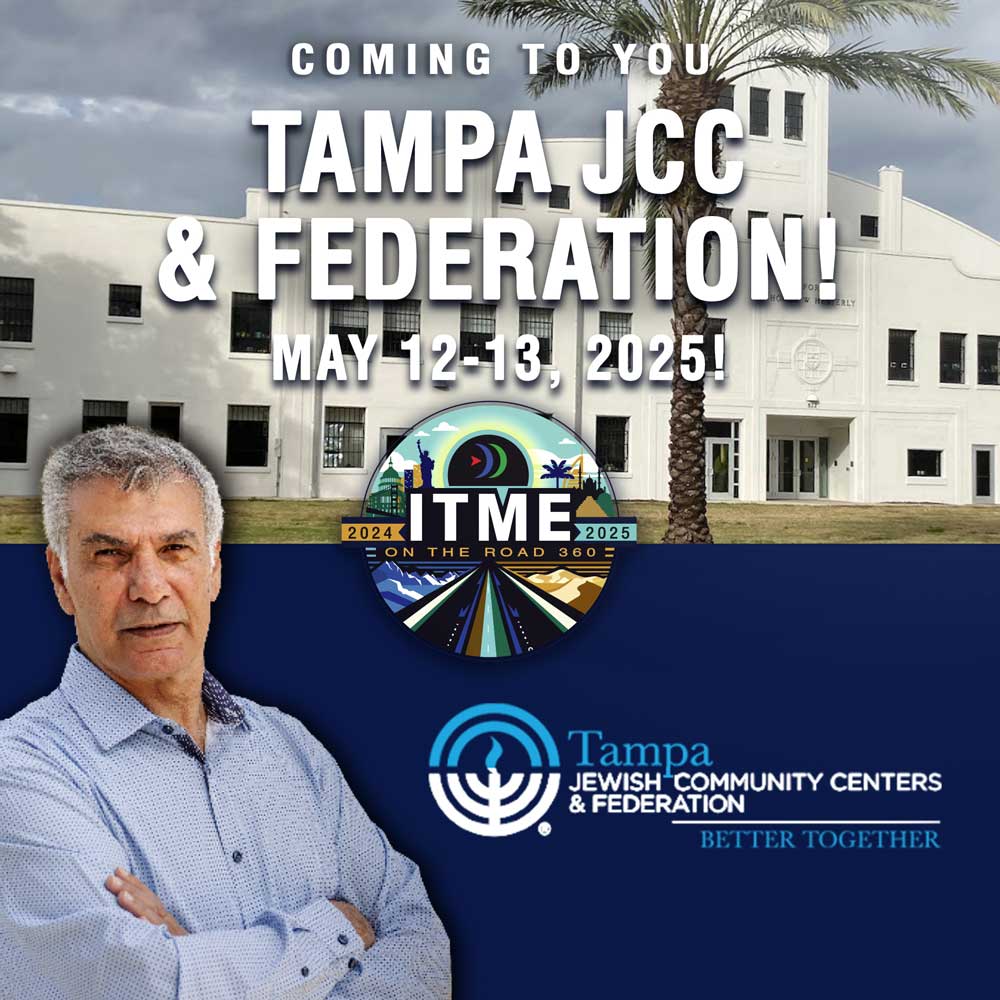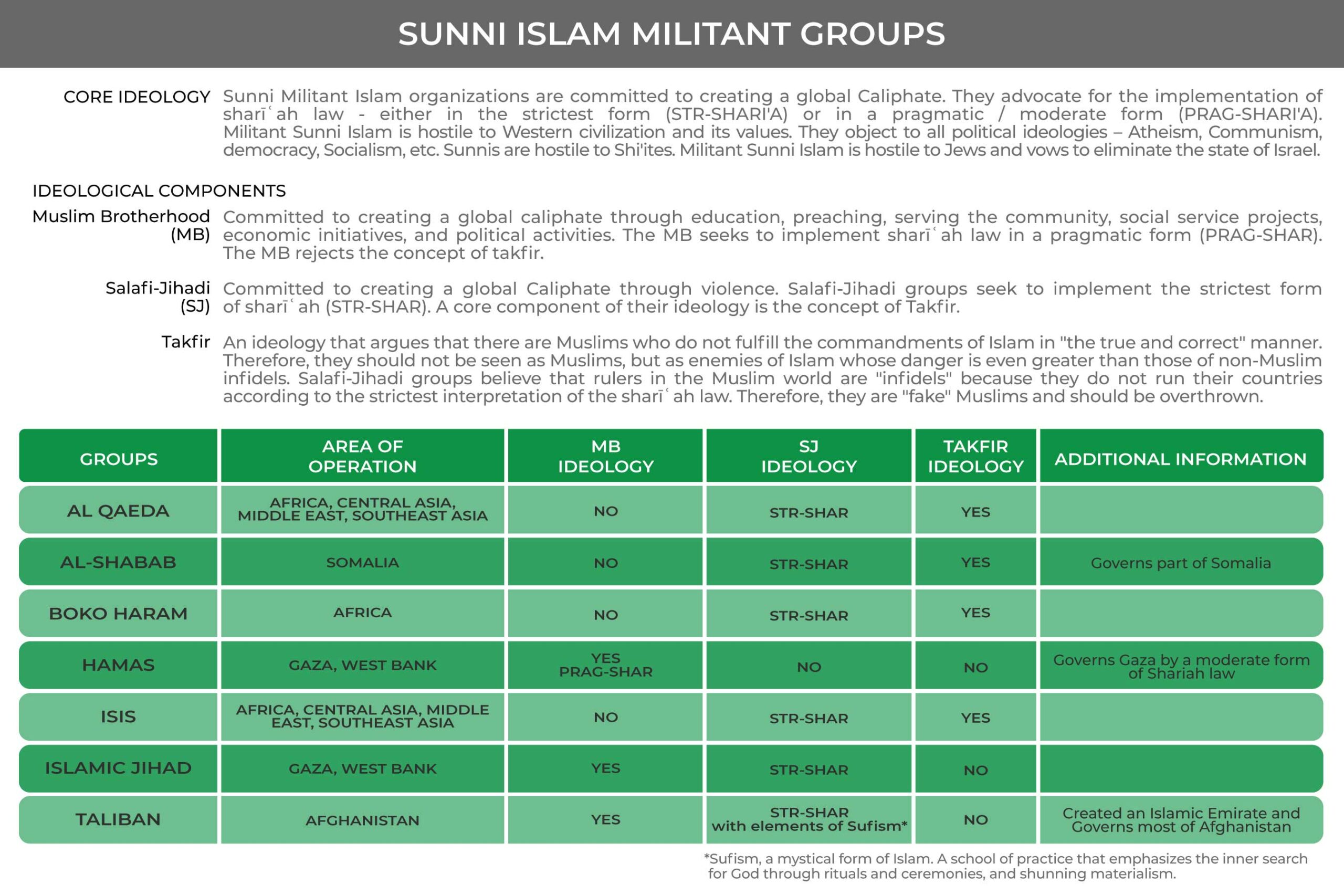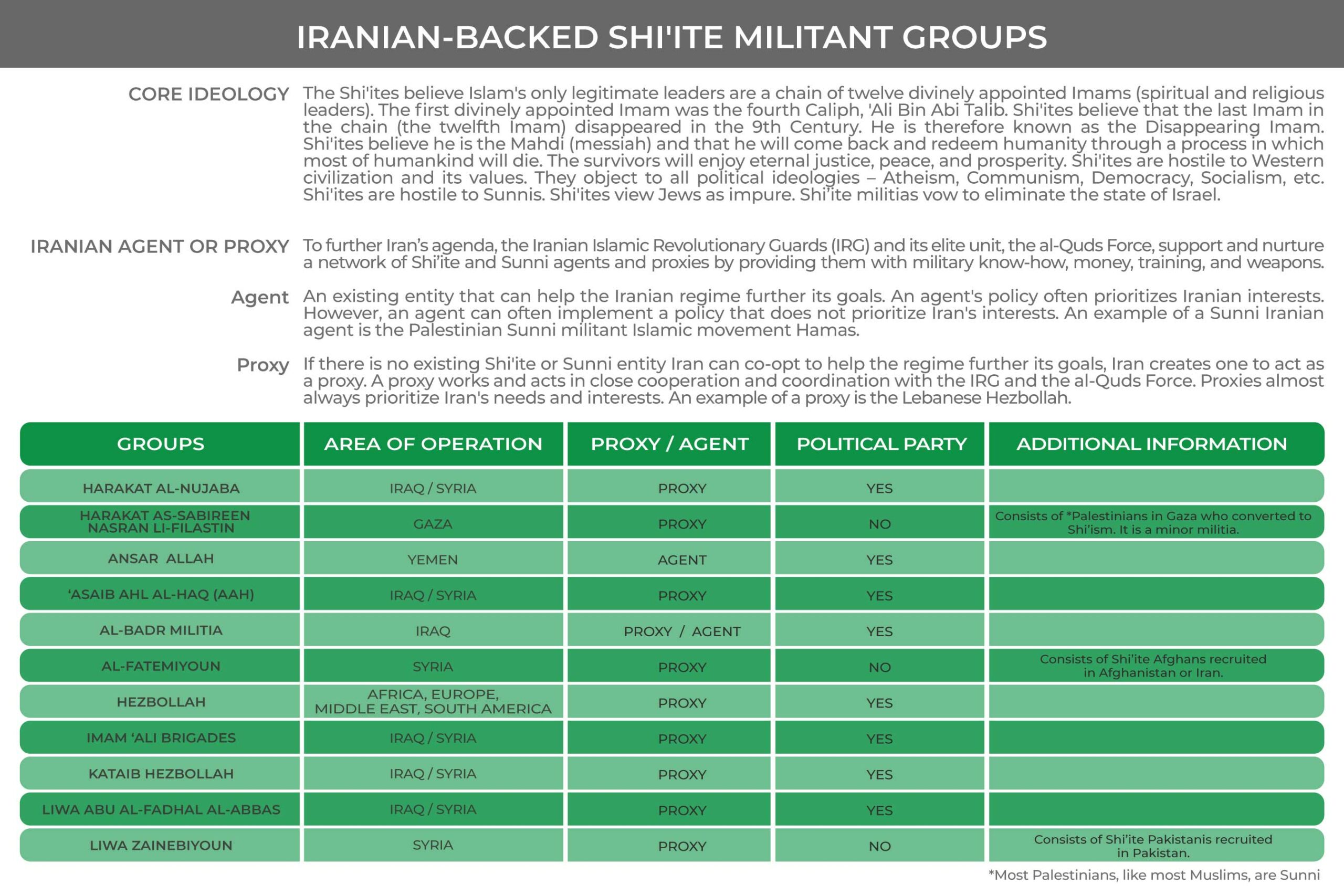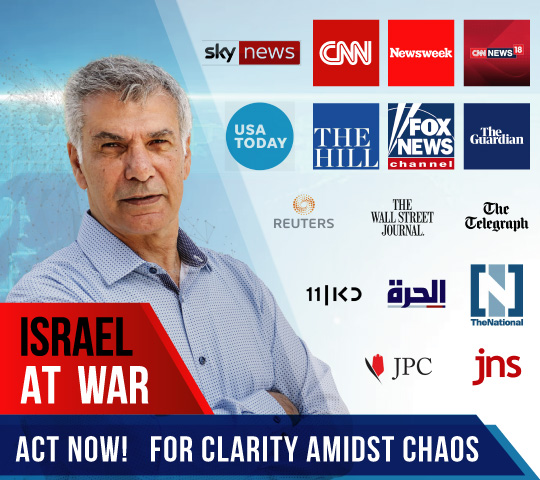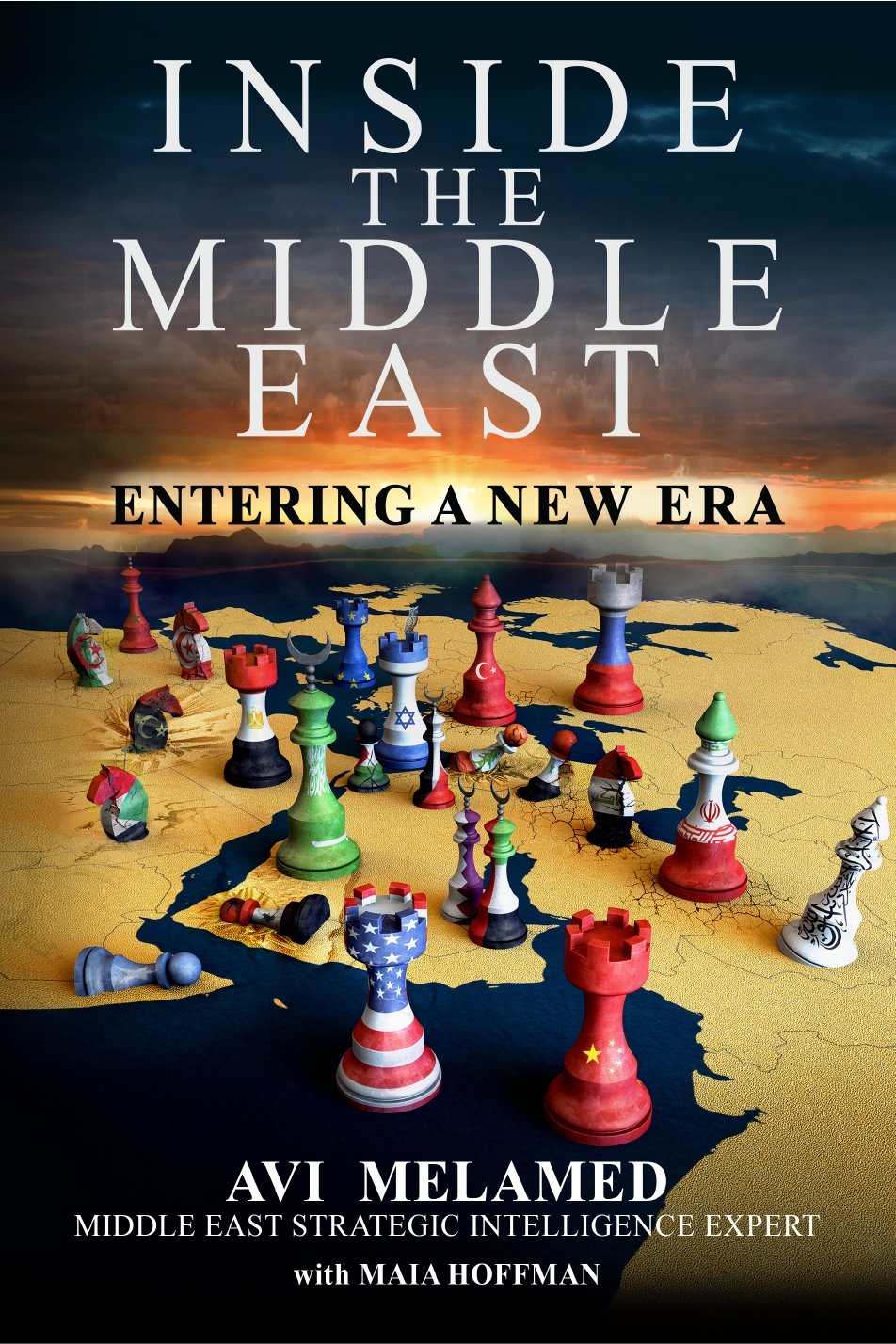|
Getting your Trinity Audio player ready...
|
Session Four | THE PAST IS PRESENT – ARAB, IRAN, TURKEY POWER STRUGGLE
Session Agenda
Summary | Where We Left Off
The Sunni-Shi’ite Split
Ancient Arab, Persian, Turkish Power Struggle
The Shi’ite Crescent
Islamic Revolution in Iran
The Iranian Regime Expansion Model
AL-Muqawama W’al Muman’aah |“The Resistance And Defiance”
Turkish ‘New-Caliphate’ Vision | Claiming the Leadership of Sunni Islam
Recep Tayyip Erdoğan Aspiring to Be the Sunni Sultan Sunni
Turkey’s Hegemonic Vision | The Gulf to the Mediterranean
Turkey & Iran | Hegemonic Vision & Five Arenas of Frictions
Mihwar Al E’itidal | The Alliance of Moderation
Introduction to the Next Class + Q & A
Overview
In this session, we explore key historical and contemporary issues shaping the Middle East. The session covers the Sunni-Shi’ite split, ancient power struggles among Arabs, Persians, and Turks, and Iran’s revolutionary expansion model. We delve into the Shi’ite Crescent, the Iranian regime’s strategy, and the concept of Al-Muqawama W’al Muman’aah (Resistance and Defiance). Turkey’s “New Caliphate” vision, under Recep Tayyip Erdoğan, is discussed, including Turkey’s hegemonic goals and Erdoğan’s five-pillar strategy. Finally, the session examines Turkey-Iran friction and the Alliance of Moderation, including Israel’s role.
Background Reading For Session 4
SUMMARY | WHERE WE LEFT OFF
Militant Islam that appeared in the 20th century is the product of three main factors:
- Fundamentalist thinking that existed in Islam throughout history.
- The direct encounter with the West that revealed the inferiority of the Islamic world in relationship to the West.
- The socio-political economic hardships in the Muslim and Arab world, corrupt & oppressive regimes & rulers
THE SUNNI-SHI’ITE SPLIT
Background information is on Background Document from Session One.
ANCIENT ARAB, PERSIAN TURKISH POWER STRUGGLE
Background information is on Background Document from Session One.
THE SHI’ITE CRESCENT
THE ISLAMIC REVOLUTION
The Iranian mullah regime came to power in 1979. In a series of events called the Islamic Revolution, Ayatollah Ruhollah Khomeini and his followers seized power from Shah Mohammad Reza Pahlavi. He ruled Iran from 1941 to 1979. The Pahlavi dynasty had ruled the Imperial State of Iran since 1925.
On April 1, 1979, Iranians approved a new constitution creating a theocratic republic named the Islamic Republic of Iran.
The Islamic Republic of Iran is an Islamic Shi’ite theocracy ruled by mullahs. The word mullah is an Islamic clerical term. A mullah is a learned scholar of Islamic theology who is authorized to share his knowledge.
The Shi’ite clerical order is hierarchical, and therefore the Iranian regime itself is hierarchical. The central figure of the Islamic Revolution and the supreme leader of the Iranian Islamic Republic until his death in 1989 was Ayatollah Ruhollah Khomeini. The title ayatollah is two words (pronounced as one word; however, it is made of two words—aya “sign, flag, verse” and Allah “The God”) that together mean “sign of God.” The current supreme leader since 1989 is Ayatollah Ali Khamenei. The most senior Shi’ite cleric is ayatollah ‘uzma— “the grand ayatollah.”
As we learned in the first session, one of the core Shi’ite narratives is that their God-given right to lead the Muslim world was stolen from them in 680 when Hussein Bin ‘Ali Bin Abi Talib was killed in Karbala. Inspired, guided, and motivated by that belief, the Iranian mullah regime is determined to take back its rightful place as the leader of the Muslim world. To that end, since coming to power in 1979, Tehran has designed and pursued an aggressive foreign policy called “exporting the Islamic Revolution.”
The goal of “exporting the Islamic Revolution” is to spread Shi’ite Twelver orthodoxy, expand the Islamic Republic of Iran’s control and influence, and ensure that Iran becomes the dominant superpower in the Middle East.
A note about Twelver orthodoxy. The largest denomination in Shia Islam is the Twelver branch, also known in Arabic as the Imamiyyah. About 85 percent of Shi’ites are Twelvers. Twelvers believe that twelve divinely ordained imams succeeded the Prophet Muhammad. The line starts with the fourth Caliph ‘Ali Bin Abi Talib. A general definition of imam is one who leads Muslim worshippers in prayer. In a global sense, the term imam refers to the head of the Muslim congregation (the ummah). According to the Twelvers, the last imam, Imam al-Mahdi, disappeared as a small child in the ninth century. And he is waiting “outside of time” to come back as the Mahdi “The Rightly Guided One.” The Redeemer. When he returns, he will lead humanity to eternal prosperity and justice through a process in which most people in the world will perish.
THE IRANIAN REGIME’S EXPANSION MODEL
To export the Islamic Revolution, one of the first things the mullah regime created was a military force that would function parallel to the Iranian Armed Forces.
The additional army it created in May 1979 was named the Islamic Revolutionary Guards Corps (IRG or IRGC).
The IRG’s mandate is to protect the mullah government and ensure it stays in power; to protect the government from external military threats; to develop and implement the strategy necessary to export the Islamic Revolution; and to secure Iran as the dominant force in the region.
The Islamic Revolutionary Guards Corps is enshrined in the constitution: In the formation and equipping of the country’s defense forces, due attention must be paid to faith and ideology as the basic criteria. Accordingly, the Army of the Islamic Republic of Iran and the Islamic Revolutionary Guards Corps are to be organized in conformity with this goal, and they will be responsible not only for guarding and preserving the frontiers of the country but also for fulfilling the ideological mission of jihad in God’s way; that is, extending the sovereignty of God’s law throughout the world (this is in accordance with the Qur’anic verse. “Prepare against them whatever force you are able to muster, and strings of horses, striking fear into the enemy of God and your enemy, and others besides them” [8:60])
Since 1979, the IRG has evolved to become the most powerful political and military body in Iran and Iran’s wealthiest entity.
In 2023, the IRG is the power center in Iran.
The IRG commands many aspects of Iranian politics and controls all of Iran’s critical economic sectors. The commander-in-chief of the Islamic Revolutionary Guards Corps since the Spring of 2019 is IRG Major General Hossein Salami. As the commander of the IRG, he is under the direct command of Iran’s Supreme Leader Ali Khamenei.
On the other hand, the Iranian Armed Forces are under the command of the Ministry of Defense, which is a political appointment. Since 2016, the chief-of-staff of the Iranian army has been Major General Mohammad Bagheri. Major General Bagheri’s power pales in comparison to the power and status of Major General Hossein Salami.
Al-Quds Force
Within the IRG, there is an elite unit called the al-Quds Force. Al-Quds is the Arabic name for Jerusalem. The al-Quds force’s specific mission is to spearhead Iran’s goal of regional hegemony strategically and tactically. Its task is to develop, command, nurture, and manage a network of Iranian proxies, agents, and terror cells in the region and around the world to achieve this goal.
Basij Force
Another force under the command of the IRG is the Basij Resistance Force (usually just called Basij). The Basij is a volunteer paramilitary organization that includes children as young as twelve years old. The omnipresent organization known as “the eyes and ears” of the regime is spread throughout Iran. It is primarily responsible for internal security, law enforcement, morality policing, and maintaining law and order. The Basij is a vast and fierce force the mullah regime uses to oppress political demonstrations and suppress dissent.
SIX-PILLAR STRATEGY TO EXPORT THE ISLAMIC REVOLUTION AND ACHIEVE REGIONAL HEGEMONY
The Iranian regime employs a sophisticated six-pillar strategy to export the Islamic Revolution to spread Shi’ite orthodoxy, expand Iran’s control and influence, and achieve regional dominance.
1. International Relations and Diplomacy. Diplomatic, commercial, and military relations with other states.
2. Educational, Charitable, and Cultural Activities. These are often used as shadow operations, money laundering mechanisms, or hidden channels that are actually put in place to finance and operate terror cells around the world, including Africa, the Arab Gulf Monarchies, Europe, Israel, the Palestinian territories in the West Bank, South America, and more.
3. Agents & Proxies Iran has a network of agents and proxies—armies of terror—across the Middle East that are massively armed and financed by Iran. This network is Iran’s most essential and powerful mechanism to expand its control and pave its way to regional hegemony.
Here is how the Iranian agent-proxy model works.
Iran identifies locations that can help the regime meet its hegemonic goals. Preferably areas with a large Shi’ite population that also suffer from chronic political instability and have a weak government.
Once Iran identifies such an arena, it either creates a proxy or cultivates and nurtures an existing force as an agent.
If Iran can find an existing entity that can help the regime further its goals, Iran will cultivate that agent.
Examples of agents are the Palestinian Sunni Islamist groups, Hamas and Islamic Jihad in Palestine (IJIP) in the Gaza Strip (though both are Sunni, not Shi’ite), and Ansar Allah, the military force of the Shi’ite Houthi tribes in Yemen.
If there is no existing Shi’ite or Sunni entity Iran can co-opt, Iran creates one to act as a proxy.
Examples of proxy Shi’ite militias Iran has created are the Afghani Al-Fatemiyoun, the Iraqi ‘Asaib Ahl al-Haq, Harakat al-Nujaba, Kataib Hezbollah, Imam’ Ali brigades, the Lebanese Hezbollah; Pakistani Liwa Zainebiyoun; and the Palestinian Harakat as-Sabireen Nasran li-Filastin in the Gaza Strip.
Iran’s extensive military arsenal—including the largest missile force in the Middle East—is the backbone of Iran’s agent and proxy militias. Iran cultivates its agents and proxies by supplying them with ammunition, financial support, manpower, technical assistance, training, weapons, etc.
Iran has successfully leveraged the agent-proxy model to gain growing influence and control throughout the Middle East.
Through its network of agents and proxies, Iran now:
- Dictates Lebanon’s domestic and foreign policy through Hezbollah.
- Occupies parts of Syria via local and regional Iranian-backed Shi’ite militias, the Islamic Revolutionary Guards forces, and the IRG’s elite al-Quds force.
- Significantly influences Iraqi domestic politics, regional policy, and the Iraqi economy via Iranian-backed Iraq-Shi’ite militias and political allies.
- Influences Yemenite politics and has a foothold on the ground in Yemen, on the Bab el-Mandeb Strait, and the Red Sea via the Yemenite Houthis
- Influences the Gaza Strip, fuels the flames of the Israeli-Palestinian conflict, and has a foothold on the ground in Gaza via Hamas and Islamic Jihad in Palestine. Each one of these achievements exceeds the specific country or territory. The locations Iran has chosen are not random. Each arena is part of a considered and calculated regional strategy with a very clear goal. To be the regional—and then, a global—superpower. Iran’s agent-proxy model has secured strategic assets and geographic strongholds for Iran. And accordingly, it has increased its power.
Employing this strategy, Iran now has established:
- An Iranian-controlled land corridor from Iran through Iraq, Syria, and Lebanon to the Mediterranean Sea.
- A foothold in Iraq—one of the largest oil producers in the world
- A stronghold on the Mediterranean Sea—the Gaza Strip, Lebanon, and Syria
- A significant foothold on one of the most strategic spots on the planet— the Bab el-Mandeb Strait at the southern entrance of the Red Sea. Through its network of proxies and agents, Iran continues to skillfully use these tried-and-true mechanisms of inciting violence and capitalizing on the chaos to advance its aggressive expansion policy and establish, deepen, and entrench its influence throughout the Middle East. And Tehran has been quite successful in its endeavor. So much so that Iranian leaders boast that they control four Arab state capitols.
AL-MUQAWAMA W’AL MUMAN’AAH | “THE RESISTANCE AND DEFIANCE”
Al-Muqawama w’al muman’aah means “The Resistance and Defiance.”
It is a concept that became popular in the Muslim world’s intellectual, political, and cultural discourse following World War II. At that time, al-Muqawama, “the Resistance,” was primarily about the struggle to end Western control in North Africa.
In its essence, al-Muqawama’s core philosophy is a blend of traditional Arab values and modern global aspirations.
Advocates of al-Muqawama believe that the best way for Arabs and Muslims—as communities and as individuals—to live is by rejecting Western cultures and powers and creating a cultural and political life whose core is the noble tradition of Arab culture and Islam’s enlightened moral values. But inherent in al-Muqawama are also modern political concepts, including emancipation, independence, and statehood.
The establishment of the State of Israel in 1948 and the evolving Israeli-Arab conflict added another layer to the concept of al-Muqawama. Al-Muqawama became the rallying cry calling to ‘Liberate Palestine’ and destroy the State of Israel.
The phrase, al-Muqawama, has become part and parcel of the vernacular of the modern Middle East. The successful branding of al-Muqawama has in many ways defined a generation of Muslims—both Sunni and Shi’ite— throughout the Middle East and around the world.
Leaders throughout the Muslim world have used al-Muqawama to rally the masses. The mullah regime in Tehran understood the centrality of the Israeli-Palestinian conflict in the hearts and minds of the Arab world.
Most of the Palestinians—like most Muslims—are Sunni. The Shi’ite regime knew that if it positioned itself as the defender of the Palestinians, it would earn points in the Arab Sunni world and smooth over the resentments of Arabs toward their historical rival—the Shi’ite (Persian) Iranians.
Building on the rallying cry to destroy Israel, the Iranians identified al-Muqawama as the narrative that could pave their path to regional supremacy. And so, the Iranian mullah regime decided to position itself as the spearhead of al-Muqawama to ‘Liberate Palestine.’
Under the banner of al-Muqawama, Iran recruits, cultivates, trains, finances, and manages a global infrastructure. This network is called ‘Mehwar al-Muqawama w’al Muman’aah’—“The Axis of Resistance and Defiance.”
The axis of resistance is a powerful web of Shi’ite and Sunni agents, allies, and proxies—non-state, semi-state, and state entities—cultivated, developed, armed, and sponsored by the Iranians.
The Shi’ite part of the axis of resistance and defiance is comprised of agents and proxies, including Shi’ite militias in Iraq; Hezbollah in Lebanon; the Assad regime in Syria (Assad is Alawite; the Alawites, who are a minority in Syria, are a distant branch of the Shi’ites); Afghan and Pakistani Shi’ite militias in Syria; and the Houthis in Yemen (the Houthis are Zaidiyyah Shi’ites—the second largest group after the Twelver Shi’ites.)
The Sunni part of the axis of resistance and defiance is primarily comprised of Palestinian militant Islamist organizations Hamas, Islamic Jihad in Palestine (IJIP); the Popular Resistance Committees in the Gaza Strip; and a militia called Saraya al-Muqawama al-Lubnaniya “The Lebanese Resistance Brigades” located in southern Lebanon—particularly around the coastal city, Sidon, which is Lebanon’s third-largest city, and predominantly Sunni.
For Iran, adding the goal of ‘Liberating Palestine’ to the already present cry calling for ‘the destruction of the State of Israel’ turned the slogan of al-Muqawama into a perpetually winning card for Iran.
The Iranian regime uses the slogan of al-Muqawama and the axis of al-Muqawama w’al muman’aah to fan the flames of the Israeli-Palestinian conflict. And this creates a permanent and continuous loop to advance its hegemonic vision.
Here is how the mullah regime’s strategy works:
Hamas and IJIP vow to destroy Israel. And they are committed to eliminating Israel through the use of military power. Therefore, their goals and interests overlap with Iran’s.
The mullah regime equips Hamas and IJIP with arms, military know-how, and financing, knowing it will further fuel the violence between Gaza and Israel.
The escalating violence feeds hatred toward Israel in the Arab and Muslim world. That further injects and embeds the slogan of al-Muqawama into the hearts, minds, and public discourse of the Arab world.
And this is how Iran etches in the hearts and minds of the Arab and Muslim world that the mullah regime is leading the charge to eliminate Israel and liberate Palestine. The concept of al-Muqawama, the axis of resistance and defiance, and the call to ‘Liberate Palestine’ is the perfect mechanism for Iran. They work hand in glove to continue to incite hatred of Israel, position Iran as the defender of the Palestinians, the patron of the axis of resistance, and the liberator of Palestine. This triad—that Iran both controls and capitalizes on—ensures the Israeli – Palestinian conflict never ends. And that is good for the mullah regime.
TURKISH ‘NEW-CALIPHATE’ VISION | CLAIMING THE LEADERSHIP OF SUNNI ISLAM TURKEY’S HEGEMONIC VISION
RECEP TAYYIP ERDOĞAN | ASPIRING TO BE THE SUNNI SULTAN
Sunni Islamist Recep Tayyip Erdoğan was mayor of Istanbul from 1994 to 1998. He was prime minister of Turkey from 2003 to 2014. And he was elected president of Turkey in 2014—a position he still holds as of 2021.
Under the tight dictatorship of Erdoğan, Turkey has become, in a way, a one-man show.
Since coming into power, Erdoğan has single-handedly changed Turkey’s face from a secular democracy to an Islamist autocracy.
Erdoğan wants to restore the glory days of the Ottoman Empire and position himself to be the leader of the Sunni Middle East and a Pan-Islamic first line leader.
Inspired by the Muslim Brotherhood ideology, pursuing his pan-Islam, neo-Ottoman, hyper-nationalism, Erdoğan leverages collapsing governments, growing chaos, and spiraling instability in the Middle East, Africa, and beyond to spread his influence, power, and pave his path to supremacy. Erdoğan—a skillful, cynical, and driven leader—pursues every opportunity he can to amass power and influence.
When Erdoğan took office as the prime minister in March 2003, he pursued a “Zero Conflict” policy. Turkey was going to be friends with everyone. Yet Erdoğan’s ideology, ambition, personality, and aggressive and provocative expansionist policies have pitted Turkey against regional and global players.
“MAVI VATAN” (“BLUE HOMELAND”) DOCTRINE
Turkey and the Eastern Basin of the Mediterranean Sea
Of all the areas Erdoğan is looking to control to achieve his hegemonic ambitions, he is most interested in the eastern Mediterranean, which is another sensitive arena of regional and global importance.
The eastern Mediterranean is where Erdoğan has been the most active—and the most aggressive.
In 2006, Turkey announced a new maritime strategy called “Mavi Vatan” “The Blue Homeland Doctrine.”
The plan is presented to end Turkey’s near-complete dependence on foreign energy sources and convert Turkey into a net energy exporter by controlling the surrounding waterways—the Black Sea, the Aegean Sea, and the Mediterranean Sea. Turkey is a massive consumer of natural gas and depends on external sources. Its two major suppliers are Russia and Iran.
However, in its essence, Mavi Vatan is an expansionist hegemonic strategy that Turkey has developed to exert its regional and international economic, militaristic, and political superiority to aggressively assert a claim over the contested, potentially gas- and oil-rich regions of the Eastern Mediterranean.
In the current geopolitical vernacular, Mavi Vatan is shorthand for Turkey’s desire to control the Eastern Mediterranean.
The Eastern Mediterranean is an area of utmost importance to the states in the region and a potential source of explosive geopolitical tensions.
Over the past decade, the Mediterranean countries and the Gulf monarchies have become geopolitically linked. And much of this is due to Erdoğan’s increasing pursuit to upend the balance of power by looking for every opportunity to insert himself and pursue his neo-Ottoman hyper-nationalist agenda.
ERDOĞAN’S FIVE-PILLAR STRATEGY TO REVIVE THE OTTOMAN EMPIRE
Erdoğan capitalizes on chaos and instability to expand Turkey’s influence and power.
Like Iran, Erdoğan uses various tools and mechanisms to spread his control throughout the Middle East and Africa.
Erdoğan employs a sophisticated five-pillar strategy to spread Sunni orthodoxy, expand Ottoman influence and power, and position himself as the leader of the Sunni camp in the region and as a frontline leader of the Muslim world.
1. International Relations and Diplomacy Diplomatic, commercial, and military relations with other countries.
2. Humanitarian Aid, Assistance, and Welfare Services from the Levant to Africa, NGOs and organizations supported by the Turkish government like the Turkish Red Crescent, the Turkish Federation of Humanitarian Associations, and others build schools that teach a political Islam curriculum and build mosque complexes to spread Islamist ideology, expand political Islam, and increase Erdoğan’s influence.
Most of the projects are funded by government agencies. And other public and private initiatives—from education and training to military arms sales—are carried out by companies that present themselves as independent but are arms of the regime or closely affiliated with Erdoğan.
Like in the case of Iran, many are shadow operations for recruiting and financing terror organizations. The Foundation for Human Rights and Freedoms and Humanitarian Relief (IHH) is one of the leading entities Erdoğan uses to further his political agenda and goals abroad. The IHH is a front charity that was accused of smuggling arms to al-Qaeda-affiliated jihadists in Syria. The IHH was also used to transport wounded ISIS and al-Qaeda fighters by ambulance from Syria to Turkey. Erdoğan used the IHH to organize provocative flotillas to Israel under the guise of humanitarian activity. And the IHH is reportedly expanding its activities into south Yemen.
3. Playing Both Sides of the Fence. Erdoğan is a calculated and shrewd politician who is always looking for opportunities to help him achieve his nationalist, religious, and political goals. And that often means holding the stick at both ends.
Erdoğan provides and sells intelligence and provides security and military hardware, know-how, and training to state and non-state actors and legitimate governments. And on the other hand, he arms, supports, aligns himself, cooperates, and often benefits from known terror organizations.
On the one hand, Turkey defines Salafi-jihadi groups as terror organizations. Yet, on the other hand, Erdoğan uses them as powerful pawn to further his own objectives. For example, Turkey supported the Islamic State ISIS established in eastern Syria because ISIS was fighting the Kurds in eastern Syria. And this served Turkish interests. So, the relationship was mutually beneficial.
And outside of the Middle East, Erdoğan nurtures a network of Islamic terror organizations in Africa.
The war in Syria is an excellent example of the nimble and cunning Erdoğan. Before the war in Syria, Erdoğan and Assad were close allies. As the war evolved into a Sunni-Shi’ite battle, Erdoğan wagered that it was beneficial to him and his greater ambition to line up against Assad. And positioning himself on the Sunni side and as the Sunni patron has served him. He has leveraged the war in Syria to further his own hegemonic mission on many levels. He has gained territory—parts of northern Syria became a Turkish protectorate. And the war in Syria has helped him gain proxies. And that brings us to the following tool Erdoğan uses to further his domestic priorities, such as preventing Kurdish autonomy in northern Syria or Iraq, advancing his hyper-nationalistic goals, and expanding the territory he controls from Africa to the Gulf and beyond.
4. Agents and Proxies Whereas Iran cultivates, develops, and supports mainly (but not only) Shi’ites to spread the Islamic Revolution and Twelver Shi’ism, Erdoğan focuses, of course, on Sunnis.
Given that 80 percent of Muslims are Sunnis, this gives Erdoğan a large pool—from both the militant Islam camp (Salafi-jihadi) and political Islam camp (and mainly the Muslim Brotherhood).
And as Erdoğan’s presence throughout the Middle East and Africa grows, so do his proxies.
In Africa, Iraq, Lebanon, Libya, Syria, Yemen, etc., Erdoğan uses his growing presence to gain more subcontractors to help him spread his power and influence—culturally, militarily, politically, religiously, etc. A principal Turkish agent in Syria is the Free Syrian Army (FSA). The FSA was the primary Syrian rebel body in the first years of the war in Syria. Turkey has trained and equipped the FSA since 2016. In 2019, it renamed itself the Syrian National Army (SNA). The SNA has 22,000–35,000 fighters. Erdoğan’s strongest proxy is in north Syria: the National Liberation Front (NLF) is a Turkish-sponsored network of twenty-two rebel militias. The dominant militias in the NLF are a Salafi militia—Ahrar al-Sham and a Muslim Brotherhood militia—Faylak al-Sham. Reportedly, the NLF has approximately 70,000 militants—including Muslim Brotherhood and Salafi-jihadi militias.
The Salafi-jihadi Hayat Tahrir al-sham (HTS) is another example of a Turkish proxy. The HTS is a coalition made up of several Salafi-jihadi militias in Syria. HTS’s early roots go back to 2012. Back then, al-Qaeda’s branch in Syria was called Jabhat al Nusrah (li) Ahl al-Sham, “Supporters’ Front for the People of ash-Sham.” Ash-Sham is the Arabic name that, for centuries, referred to a geographic area of Mesopotamia—consisting of what is today Israel, Lebanon, Syria, Jordan, and Iraq. In July 2016, Jabhat al Nusrah (li) Ahl al-Sham split from al-Qaeda and called itself Jabhat Fath al-Sham “The Front for al-Sham’s Triumph.” In January 2018, Jabhat Fath al-Sham created a coalition with other Salafi-jihadi groups in Syria. The new alliance was named Hayat Tahrir al-Sham (HTS).
In addition to its Syrian Salafi-jihadi proxies, Turkey uses non-Syrian and non-Arab Sunni militias of Kazakhs, Turkmen, and Uighurs. They came to Syria to join the war and fight Assad, Iran, and their proxies.
5. Al-Muqawama w’al Muman’aah—“The Resistance and Defiance” Like the mullah regime, Erdoğan understood the centrality of the IsraeliPalestinian conflict in the hearts and minds of the Muslim world.
Like Iran, Erdoğan also knew that using al-Muqawama and positioning himself as the defender of the Palestinians would earn him points throughout the Arab and Muslim world.
Hamas defines itself as the Muslim Brotherhood branch in Palestine.
Coming from the same Islamist and ideological womb, Erdoğan supports Hamas primarily—but not solely—diplomatically and financially. Erdoğan makes a concerted effort to position himself as the world leader that provides humanitarian aid to Gaza. Whether it is flotillas or trucks—the amount of support Turkey provides to the Palestinians is more symbolic—first aid supplies, food parcels, hygiene kits, toys for children, etc. Nonetheless, Erdoğan creates an entire marketing and public relations effort each and every time. The broad media exposure managed by Istanbul gives Erdoğan points in the Muslim—and partially Arab—public opinion.
TURKEY & IRAN | HEGEMONIC VISION & FIVE ARENAS OF FRICTIONS
Four out of the five are maritime arena: The Arab/Persian Gulf, the Hormuz Strait, the Arabian Sea, the Gulf of Aden, the Bab el-Mandeb Strait, the Red Sea, the Suez Canal, and the Eastern basin of the Mediterranean Sea. They are a lynchpin of international trade, a cornerstone of global security, and the center of some of the world’s most important natural resources.
These major naval, shipping, and trade routes that cross through the region are increasingly a platform for friction, hostility, and violence fueled by the hegemonic ambitions of Iran and to a lesser extent—in the Mediterranean—Turkey.
The fifth arena is a land corridor stretching from Iran through Iraq, Syria, and Lebanon. The Lebanese, Syrians, and Iraqis are fighting for independence and struggling for sovereignty.
MIHWAR AL E’ITIDAL | THE ALLIANCE OF MODERATION
The Arab world’s desire to position itself and strengthen its position in the twenty-first-century economy, hand in hand with their need to counter Turkey and Iran’s hegemonic ambitions, is at heart a regional alliance This informal confederation is known as Mihwar al E’itidal—the “Alliance of Moderation.”
The members of the alliance of moderation (in alphabetical order) are Bahrain, Egypt, Jordan, Kuwait, Morocco, Oman, Saudi Arabia, and the United Arab Emirates. On the perimeter of this coalition, we can also add Arab countries like Sudan, and Tunisia, who, for the most part, advocate for and support policies that are aligned with the alliance’s interests. In its essence, the paramount goal for the alliance of moderation is stability within their own individual countries—and stability throughout the region.
There is another silent yet significant member of this coalition. And that is Israel. Israel is a regional power, and Israel is also directly threatened by the Iranian and Turkish hegemonic aspirations. The Arab members of the alliance see Israel as a stable, valuable, and strong strategic partner.
Israel’s role within the framework of the alliance of moderation is a very well-known secret. The relationship between Israel and the Arab Gulf monarchies has evolved and deepened. The security cooperation between Israel and Egypt as well as between Israel and Jordan has grown and expanded. One can assume Israel has a strong and strengthening intelligence and security cooperation with other members of the alliance—even with those with which Israel has no formal relations.
Lexicon for Session 4
Allah
The One God
The Abraham Accords
The agreements signed by Bahrain, Israel, the United Arab Emirates, and the United States on September 15, 2020. The UAE signed a Peace Treaty, including instating full diplomatic relations and normalization. Bahrain signed a Peace Declaration launching peace talks. Morocco joined the Abraham Accords in December 2020. And Sudan formally joined in January 2021.
Al-Aqsa
Literally translated as “The Far Edge” in Arabic. Over time the term has become synonymous with Jerusalem.
Al-Aqsa Mosque
The third holiest site in Islam, after Mecca and Al-Medina. The mosque is located in the Old City of Jerusalem on the Temple Mount Compound / Har Ha Bayit / Al-Haram al-Sharif. The original structure was built in 705 but has been rebuilt several times.
Al Badr Corp / Militia
A Pro-Iranian Iraqi Shi’ite political party and militia headed by Hadi al-Amiri.
Al Bukamal
A Syrian town next to the Syria-Iraq border crossing. The passage on the Syrian side is called Al Bukamal. On the Iraqi side, the crossing is named al-Qaim. Iran has built on the Syrian side next to the border crossing a military infrastructure called the Ali Imam Compound. The compound is one of the most critical links in the Iranian corridor.
Al-Hashd Al-Sha’abi
“The Popular Resistance Committees” or “PMU.” A state-sponsored umbrella organization made up of Iraqi militias (most of whom are Shi’ite). The origin of the PMU was a group of militias that fought from 2014 to 2017 alongside the Iraqi army to defeat ISIS in Iraq. In July 2016, the Iraqi parliament passed a law making these militias an official Iraqi military apparatus that operates in parallel to the Iraqi military. The main PMU militias are close to Iran, and some of those militias are practically under the command of the Iranian Revolutionary Guards (IRG)
Al Islam Huwa al-Hal
“Islam is the Solution”—a central slogan of the Muslim Brotherhood.
Al-muqawama al-Masullah
The Armed Resistance
Al-Muqawama w’al Muman’aah
“The Resistance and Defiance.” It is an idea and a concept that spread within the Muslim world’s intellectual, political, and cultural discourse following World War II. Initially, it was primarily in the context of the North African struggle to end Western control. The original idea was that the way Arabs and Muslims—as communities and as individuals—can enhance their lives is through the creation of a cultural and political life that emphasizes the enlightened moral values of Islam, the noble tradition of Arab culture, combined with the modern concepts of emancipation and statehood. In the last generation, al-Muqawama has become ‘the code word’ for the rejection of Western power, the destruction of the State of Israel, and liberating Palestine. Under this concept, Iran embraces and finances a set of execution agents.
Al-Quds
The name in Arabic for Jerusalem. The word is taken from the Hebrew word for holy, which is kadosh.
Al-Quds Force
Created in the 1990s, an elite unit and the spearhead of the Islamic Revolutionary Guards Corps (the IRGC). The IRG reports directly to Iran’s Supreme Leader. The al-Quds force is responsible for external operations outside of Iran. Their mission is to export the Islamic Revolution, spread the Twelver Shi’ite orthodoxy, and ensure Iran is the region’s leading superpower. Their primary task is to design and spearhead a strategy that mission, the cornerstone of which is constructing and operating a network of armed proxies and agents in various parts of the Middle East and beyond. As Iran’s primary arm to support and guide Iran’s nonstate partners, the al-Quds force arms, equips, funds, and trains the regime’s armies of terror. Since the US killed Major General Qasem Soleimani, the Al-Quds Force has been under the command of Major General Ismail Qa’ani. The al-Quds force is designated a supporter of terror by the US government.
Alawites
The al-Assad family in Syria is Alawite; the Alawites, who are a minority in Syria, are a distant branch of the Shi’ites. However, they have different norms and customs in comparison to mainstream Iranian Shi’ites.
Ali Bin Abi Talib (600–661)
The fourth Caliph in Islam. A cousin and son-in-law of the Prophet Muhammad, the founder of Islam. Ali was married to 9 women and had 21 children. His first wife was Fatimah, the daughter of Muhammad. And together, they had four children—two daughters—Zaineb and Um Kulthum. They also had two sons—Hassan and Hussein. ‘Ali bin Abi Talib was murdered. Hassan briefly took his father’s place and ruled the Caliphate. He stepped down. And then his brother, Hussein (Al Hussein bin ‘Ali bin Abi Talib), took the throne.
Ali Khamenei (1939–)
Iran’s Supreme Leader since 1998. He succeeded Ruhollah Khomeini, the founder of the Islamic Republic of Iran.
Alliance of Moderation “Mihwar al E’itidal”
An informal alliance of central Arab states—Egypt, members of the Gulf Cooperation Council (GCC)—Bahrain, Kuwait, Oman, Saudi Arabia, UAE—Jordan, and Israel. The alliance reflects its members’ joint strategic interests—blocking the Iranian and Turkish threats and fostering economic and technological cooperation to address current and expected needs.
Ansar Allah
The military force of the Shi’ite Houthi tribes in Yemen. An Iranian agent.
Arab/Persian Gulf
A 615-mile-long extension of the Indian Ocean between Iran and the Arabian Peninsula
Arab Syrian Army
The official military of Syria
‘Asaib Ahl al-Haq
“The League of the Righteous.” It is an Iraqi Shi’ite militia. Also known as AAH. It is one of Iran’s most important Shi’ite militias.
Ashak and Arak
“Tears and sweat.” The mullah regime sees itself as a revolutionary power that sees its role to lead the world to redemption through a process called in Farsi Ashak and Arak—in which most of humankind will die. And those that survive will be redeemed by Allah.
Ashura
The tenth day of the month of Muharram, the first month in the Islamic calendar. For Shi’ite Muslims, it marks the day that Hussein Bin Ali Bin Abi Talib, the grandson of the prophet Muhammad was martyred in the battle of Karbala in 680. This is one of the cornerstones of the Shi’ite narrative and an intense day of mourning and exhibiting martyrdom through self-flagellation. The Sunnis also celebrate Ashura. For them, it marks the day that Moses and the Israelites were saved from Pharaoh by God, creating a path in the Sea of Reeds. Sunnis fast and ask for repentance. The tenth day of the month of Muharram, the first month in the Islamic calendar. For Shi’ite Muslims, it marks the day that Hussein Bin Ali Bin Abi Talib, the grandson of the prophet Muhammad was martyred in the battle of Karbala in 680. This is one of the cornerstones of the Shi’ite narrative and an intense day of mourning and exhibiting martyrdom through self-flagellation. The Sunnis also celebrate Ashura. For them, it marks the day that Moses and the Israelites were saved from Pharaoh by God, creating a path in the Sea of Reeds. Sunnis fast and ask for repentance.
Axis of Resistance and Defiance “Mihwar al Muqawama w(al) Mumanna’ah ”
Under the banner of Al-Muqawama w(al) Mumanna’ah (the Resistance and Defiance), Iran cultivates and finances a powerful network of allies, agents, and proxies such as Hezbollah in Lebanon, Hamas and Islamic Jihad in the Gaza Strip, Iraqi Shi’ite militias, Afghan Shi’ite militias, Pakistani Shi’ite militia, the Houthi tribes in Yemen and other proxies in the region. Their role—among other things—is to help Iran in its aspiration to become the dominant superpower.
Ayatollah
Two words in Arabic that mean “Sign of God.” It is pronounced as one word; however, it is made of two words, aya (sign, flag, verse) and Allah (The God). A senior cleric status within Shi’ite theological order.
Ayatollah’ Uzma
“The Grand Sign of God.” The title for the most senior cleric within the Shi’ite theological order.
Bab El Mandeb Strait
“The Gate of Lamentation (or) Tears.” The southern entrance to the Red Sea. Eighteen miles wide at its narrowest point, it is located on Yemen’s southwestern tip, flanked from the east by Yemen and from the west by Djibouti and Eritrea. The connection between the Gulf of Aden and the Red Sea, the link between the Indian Ocean and the Mediterranean Sea, and the chokepoint between the Horn of Africa and the Middle East. The shortest route between the Mediterranean, the Indian Ocean, and East Asia—the Bab el Mandeb Strait physically connects the east and the west.
Bashar Hafez al-Assad (1965–)
President of Syria and Commander-in-Chief of the Syrian military since 2000. He succeeded his father, President (1971–2000) Hafez al-Assad (1930 – 2000).
Basij Forces
“The Organization for Mobilization of the Oppressed.” Created in April 1980, it is a paramilitary volunteer militia. It is an intimidating and far-reaching organization primarily charged to maintain order, suppress dissent, and protect the regime.
Ebrahim Raisi (1960–)
President of Iran (2021–). He is associated with the ultra-extremist current in Iran. He chaired the Judiciary Authority in Iran from March 2019 until he was elected president. He was also a member of a notorious four-member committee known as “The Death Committee”—an entity that sent thousands of Iranians to their deaths on subversion charges against the regime.
Exporting the Islamic Revolution
A strategy aimed to position the Islamic Republic of Iran as the hegemonic power in the Middle East and pave the way for the Mahdi’s return (the Messiah in Shi’ite Islam).
Free Syrian Army (FSA)
The FSA was the primary Syrian rebel body in the first years of the war in Syria. Turkey has trained and equipped the FSA since 2016. In 2019, it renamed itself the Syrian National Army (SNA). The SNA has 22,000– 35,000 fighters.
Gaza Strip
An eight-by-twenty-mile strip located on the Mediterranean Sea between Israel and Egypt, Gaza’s population is about 1.9 million people. Gaza was under Egyptian military rule until 1967 and under Israel’s military governance from 1967–2005. In 2005 Israel withdrew from Gaza and handed control to the Palestinian National Authority. In 2007 Gaza-born Hamas Islamicorganization violently terminated the rule of the P.A. in Gaza in a bloody coup. Since 2007 Hamas rules Gaza.
Hamas Harakat Al-Muqawama Al-Islamia—the Islamic Resistance Movement.
Hamas also is literally translated as a ‘religious enthusiasm.’ It is a Palestinian Islamist militant and political organization founded in the Gaza Strip in 1987. Hamas defines itself as a subsidiary of the Muslim Brotherhood movement and the branch of the Muslim Brotherhood in Palestine. Hamas’s vision is to eliminate the State of Israel in a violent struggle and establish a caliphate ruled by Islamic law in all areas of Israel. Hamas has controlled the Gaza Strip since 2007 after they launched a coup against the Palestinian Authority in Gaza. Hamas is defined as a terrorist organization by many countries. Hamas is an example of an Iranian agent.
Harakat as-Sabreen Nusran li-Filastin
A splinter group that broke off from the Islamic Jihad in Palestine organization in Gaza Strip. Backed by Iran.
Hassan Nasrallah (1960–)
Secretary-General (1992–) of Lebanese Hezbollah
Hassan Rouhani (1948–)
Seventh President of Iran (2013–2021).
Hay’at Tahrir al-Sham (HTS)
The “Organization for the Liberation of the Levant” or “Levant Liberation Committee.” A coalition of Salafi-Jihadi militias in Syria.
Hezbollah (Lebanese)
Two words that mean “Party of God.” An armed military organization and political party in Lebanon. The Islamic Revolutionary Guards Corps (IRGC) created Hezbollah in 1983. Hezbollah’s main political base is Lebanese Shi’ites. Hezbollah is Iran’s most vital and powerful proxy. Hezbollah has three ministers in the Lebanese Government and 13 members of parliament. Hezbollah is defined as a terrorist organization by many countries.
Hormuz Strait
A strait between the Persian Gulf and the Gulf of Oman. It provides the only sea passage from the Persian (Arab) Gulf to the open ocean. It is one of the world’s most strategically important choke points.
Hossein Salami (1960–)
Major General. Commander of the Islamic Revolutionary Guard Corps
Houthis
A framework of Shi’ite tribes in northern Yemen, they make up about thirty-five percent of Yemen’s population. The Houthis are Zaidiyyah Shi’ites—the oldest branch of Shi’ism and the second largest group after the Twelvers. The Houthi movement was created in 1992 by Hussein Badr al-Din al-Houthi, a Shi’a scholar. The Houthis have a historical relationship with Iran. In September 2014, the Iranian-backed Houthi militias ousted the Yemenite Government and expanded their control to other parts of Yemen. Following the failure to solve the crisis peacefully, a Saudi-led military coalition forces fights against the Houthis since March 2015 to restore the ousted Yemeni government.
Hussein bin ‘Ali bin Abi Talib (600–661)
The youngest son of Ali Ben Abi Talib (the fourth Caliph) and Fatimah, the Prophet Muhammad’s daughter. Hussein was Muhammad’s last grandsonthrough direct bloodline. Caliph Yazid of Ma’awiya killed Hussein along with his supporters in Karbala (Iraq of our times) in 680. They were killed on the 10th day of the month of Muharram, the first month on the Islamic (lunar) calendar. Ashurah means ten in Arabic. And every year, Shi’ites commemorate the event known as the Day of Ashurah by performing grief and mourning rituals. The Shi’ite narrative says that “Every day is Ashurah and every place is Karbala.” The killing of Hussein is the cornerstone of the Shi’ite story.
Imam
An Islamic leadership position. It is most commonly used as the title of a worship leader of a mosque and Muslim community among Sunni Muslims. In Shia orthodoxy, Imam is the title of the spiritual and political successors to the Prophet Muhammad.
Imamiyyah
The largest branch of Shia Islam is the Twelver—in Arabic Imamiyyah. Twelver refers to its followers’ belief in twelve divinely ordained spiritual and political successors (Imams) to the Prophet Muhammad. They are known as the Twelve Imams.
Imam al Mahdi
The Twelver Shi’ites believe there were twelve divinely ordained successors to Prophet Muhammad. They believe that the last Imam was Muhammad Bin Hasan al-Askari, born in 870 and that he disappeared as a small child. The Shi’ites believe he is waiting outside of time and history to the time he will reappear to redeem humanity. He is the messianic figure in Shi’a Islam.
Imam al Mahdi
Scouts Hezbollah’s youth movement. Began in Lebanon in 1985 and is now being replicated in Iraq and Syria.
Imam ‘Ali Brigades
Iranian-backed Iraqi Shi’ite militia.
Imam ‘Ali military Compound
A complex military installation Iran has built in Syria near the Iraqi-Syrian border. It is a vital component of the Iranian land corridor. The Imam ‘Ali Compound serves as the border crossing and a transition depot for Iranianbacked Iraqi militias heading to Syria. The passage’s name on the Syrian side is Al-Bukamal, and the name of the crossing on the Iraqi side is Al-Qa’im. In addition to the sprawling warehouses it has built, reports are that Iran has built tunnels and bunkers in the compound that store missiles and rockets. The Imam ‘Ali Compound is a keystone of the corridor. That is why it has been attacked several times by the United States. Also, reportedly Israel has attacked the installation. Israel has never claimed responsibility for those attacks.
Iranian-backed Shi’ite Militia Proxies
Examples: Afghani Al-Fatemiyoun, the Iraqi ‘Asaib Ahl al-Haq, Harakat al-Nujaba, Kataib Hezbollah, Imam’ Ali brigades, the Lebanese Hezbollah; Pakistani Liwa Zainebiyoun; and the Palestinian Harakat as-Sabireen Nasran li-Filastin in the Gaza Strip.
Iranian Land Corridor
A land bridge that begins in Iran and travels west: it crosses through Iraq, Syria, and Lebanon and ends in the Mediterranean Sea. The corridor is critical for Iran’s hegemonic vision.
Islamic Revolutionary Guards Corps (IRG or IRGC)
The IRGC was founded in 1979. Supreme Leader Khomeini created the IRG immediately after the Islamic Revolution and the creation of the Islamic Republic of Iran. An Iranian military force whose broad mission is to defend the Iranian Revolution from foreign or domestic threats. Their primary role is to protect the Islamic Republic and the Islamic Revolution against internal and external threats. It is under the command of Iran’s Supreme Leader, who, since 1989, is Ali Khamenei. The commander of the IRGC is Major General Hossein Salami. The IRG has air, ground, and naval forces. It also has aerospace, unconventional warfare, and cyber divisions. It is designated as a foreign terrorist organization by the United States. The IRG has evolved to be the wealthiest and most powerful entity in Iran and essentially controls Iran’s economy and foreign policy and wields significant influence over Iran’s domestic policy.
Iranian Agents
Examples of Iranian agents are the Palestinian Sunni Islamist groups, Hamas and Islamic Jihad in Palestine (IJIP) in the Gaza Strip (though both are Sunni, not Shi’ite), and Ansar Allah, the military force of the Shi’ite Houthi tribes in Yemen.
Iranian Proxies
Examples of Iranian proxy Shi’ite militias Iran has created are the Afghani Al-Fatemiyoun, the Iraqi ‘Asaib Ahl al-Haq, Harakat al-Nujaba, Kataib Hezbollah, Imam’ Ali brigades, the Lebanese Hezbollah; Pakistani Liwa Zainebiyoun; and the Palestinian Harakat as-Sabireen Nasran li-Filastin in the Gaza Strip
ISIS/ISIL/The Islamic State
ISIS began in 2006 as a militant Islamic militia of Sunni tribes in central Iraq. ISIS is an acronym for the “Islamic State of Iraq and Syria” or the “Islamic State of Iraq and ash-Sham.” For centuries, Ash-Sham is the Arabic name that referred to a geographic area of Mesopotamia—consisting of what is today Israel, Jordan, Lebanon, Syria, and Iraq. In Arabic, ISIS is called Da’esh. The term “Da’esh” is made of the initials “Al-Dawla al-Islamiya fi(l) Iraq wal-Sham” (the Islamic State in Iraq and ash-Sham). In April 2013, ISIS became the branch of Al-Qaeda in Iraq. They called themselves “Al-Qaeda in the Two River Countries.” The rivers are the Tigris and the Euphrates—a region historically known as Mesopotamia. In June 2014, ISIS declared its “Caliphate”—the Islamic State (I.S.). At its height, the Islamic State encompassed 30 percent of Syria and 40 percent of Iraq. In July 2014, the leader of ISIS—Ibrahim ‘Awad Ibrahim ‘Ali al-Badri al-Sameraai a.k.a. Abu Bakr al-Baghdadi—announced himself the Caliph Ibrahim. In the second half of 2017, the military pressure of the international coalition forces that joined together to fight the Islamic lexicon 555 State began to reverse some of ISIS’s gains. Throughout 2017, 2018, and 2019 ISIS suffered mounting casualties and lost strongholds. The Islamic State came to an end in 2019. The United States killed Abu Bakr al-Baghdadi in October 2019. One of the most substantial ISIS branches globally is the “Islamic Emirate of Khorasan,” also known as ISIS/K
ISIS- K
ISIS’ branch in Central Asia.
Islam
A dedication to the complete and absolute acceptance of the idea of one god—Allah. Islamic Jihad Salafi Jihadi global organization.
Islamic Jihad in Palestine (IJIP, also known as PIJ) IJIP, in Arabic, Harakat al-Jihād al-Islāmi fi Filastīn
A Palestinian Islamist militant organization. Established in the 1980s and supported by Iran. Considered as the second-largest military power in Gaza Strip (after Hamas). IJIP calls for the destruction of Israel in a violent struggle. IJIP military force called Saraya al-Quds—“The Jerusalem Companies.” IJIP is an example of an Iranian agent.
Islamic Revolution
In a series of events called the Islamic Revolution, Ayatollah Ruhollah Khomeini, and his followers seized power from Shah Mohammad Reza Pahlavi, who had ruled Iran since 1941. The Pahlavi dynasty had ruled Iran since 1925.
Ismail Haniyeh (1962–)
Born in Gaza. The Chairman of Hamas’s Political Wing / Bureau, Former Hamas Prime Minister of the Gaza Strip.
Major General Ismail Qa’ani (1958–)
Commander of the IRGC al-Quds force. He replaced Major General Qasem Soleimani, who was killed in January 2020 by the United States.
Izz ad-Din al-Qassam Brigades
Hamas’s military wing. It is named after an Islamic preacher of Syrian origin killed in the 1930s during the Arab revolt against the British Mandate in Palestine/Land of Israel
Jabhat al Nusrah (li) Ahl as-Sham/Jabhat Fatah al-Sham Front of the Supporters of the People of Syria/the Levant.
Originally Al-Qaeda’s branch in Syria. In 2015 rebranded as Jabhat Fatah al-Sham (“Front for the Conquest of the Levant”) and in 2017 merged in the frame of Hayat Tahrir as-Sham (HTS)—a conglomeration of Salafi-Jihadi organizations in Syria.
Javad Zarif (1960–)
Former Iranian Foreign Minister
JCPOA
The Joint Comprehensive Plan of Action. Also called the “Vienna Agreement,” “the Iran Nuclear Deal,” or “the Iran Deal.” An agreement was signed between Iran and the P5 +1 (the United States, the United Kingdom, France, Germany, the European Union, and China) in 2015 to limit the Iranian Nuclear Program. In May 2018, the US withdrew from the agreement.
Kata’ib Hezbollah
Iranian-backed Iraqi proxy militia closely affiliated with the Iranian Revolutionary Guards.
Liwa Fatemiyoun
A Shi’ite militia consisting of Afghans living in Iran. Iran created the militia in 2014 to fight in Syria to support Assad’s forces, keep him in power, and secure Iran’s presence in Syria. In return for their service, militants receive monthly wages and are entitled to Iranian citizenship for themselves and their families.
Liwa Zainebiyoun
Zainebiyoun Brigade, an Iranian-backed Pakistani Shi’ite militia fighting in Syria. Iran created the militia in 2014 to fight in Syria to support Assad’s forces, keep him in power, and secure Iran’s presence in Syria. In return for their service, militants receive monthly wages and are entitled to Iranian citizenship for themselves and their families. The members are Shia Pakistanis living in Iran. Zaineb is one of two daughters of the fourth Caliph ‘Ali Bin Abi Talib, and Fatimah, Prophet Muhammad’s daughter. According to Islamic tradition, she is buried in Damascus.
Mahdi
“The rightly guided one.” A Messianic figure in the Shi’ite belief who, according to Islamic belief, will appear at the end of times to rid the world of evil and injustice.
Mashhad
A city in northeast Iran known as a place of religious pilgrimage and theological Shi’ite center.
Mavi Vatan
Doctrine Blue Homeland. The doctrine is presented to end Turkey’s near-complete dependence on foreign energy sources and convert Turkey into a net energy exporter by controlling the surrounding waterways—the Black Sea, the Aegean Sea, and the Mediterranean Sea. However, in its essence, Mavi Vatan is a hegemonic strategy that Turkey has developed to exert its regional and international economic, political, and military superiority to aggressively assert a claim over the contested, potentially oil-rich regions of the Eastern Mediterranean.
IRGC Major General Mohammad Hossein Bagheri (1960–)
Armed Forces General Staff Chief (2016–). He is responsible for overseeing all Iranian military forces.
Mohsen Fakhrizadeh (1958–2020)
A Brigadier General in Iran’s Islamic Revolutionary Guards Corps. He was Iran’s top nuclear scientist and the head of Iran’s secret military nuclear program. He was killed in Iran on Friday, November 27, 2020.
Mullah
Iran is an Islamic Theocracy. Therefore, though there is a parliament and a president, the mullahs hold the power. A mullah is a Shi’ite clerical rank. Islam ranks its clerics—similar to the ranks in the Church or an army. The highest position is the ‘Ayatollah Uzma’ (The Grand Ayatollah). The highest spiritual center of the Shi’ites is located in Najaf and Karbala—cities in southern Iraq. Other major spiritual and theological centers of the Shi’a are located in Qom and Mashhad—cities in Iran. The Iraqi and Iranian Shi’ite theological centers have generated different, sometimes opposing, theological outlooks, resulting in a long history of rivalry over influence and prestige.
The Muslim Brotherhood (MB)
Founded in 1929 in Egypt by Hassan al Bana. The MB adheres to the Political Islam school of thought and is the largest mass movement in the Sunni world. The MB is organized in a hierarchical structure. The Supreme Leader is called “the General Guide.” An advisory board that assists him is called the Shurah. MB’s slogan is “Islam is the Solution” Al-Islam hu al-hal in Arabic. The MB’s goal is to establish a global Islamic framework—a Caliphate—that will be ruled according to the Islamic shari’ah law. The MB rejects the concept of “Nation States.” They argue that a nation-state’s vision is rooted in Western culture and values that contradict Islam and Islamic law (the shari’ah) and therefore defy Allah’s rule. The MB has chapters in every Muslim state in the world. The branches’ structure is like the worldwide structure and is designed to promote the movement’s ideology and values. However, each chapter has a certain degree of independence in its political position and political activities. Given that, one can indicate different—sometimes even opposing—positions of the branches regarding political issues. Against the backdrop of the Arab Spring events, the movement reached its climax. The MB won elections and thus ruled Egypt and Tunisia. And it gained power in other Arab states. However, the short-lived success—most significantly, the MB governments in Egypt and Tunisia failed and were replaced. The failure resulted in a political and ideological crisis within the MB, leading to inner splits in some of its chapters. As a result of this crisis, the pragmatic (pragmatic does not mean moderate) wing of the movement gained strength in places like Algeria, Egypt, Jordan, Tunisia, and Morocco at the expense of the more dogmatic wing.
Najaf
A city in central Iraq. It is the Shi’ite world’s spiritual capitol and the center of Shi’ite political power in Iraq. While Sunni Islam considers al-Quds (Jerusalem) as the third most sacred site in Islam, the Shi’ites consider Najaf as the third most sacred site (after Mecca and Medina). The holiest Shi’ite religious and pilgrimage sites are in Najaf and Karbala in Iraq and Qom and Mashhad in Iran. These cities are also home to the leading Shi’ite theological educational centers. The fourth Caliph, Ali Bin Abi Talib, is buried in Najaf.
National Liberation Front
Erdoğan’s strongest proxy is in north Syria: the National Liberation Front (NLF) is a Turkish-sponsored network of twenty-two rebel militias. The dominant militias in the NLF are a Salafi militia—Ahrar al-Sham and a Muslim Brotherhood militia—Faylak al-Sham. The NLF has approximately 70,000 militants.
Normalization In the vernacular of the Middle East, the concept of ‘Normalization’ is a term that means recognizing Israel’s existence in any manner or cooperating with Israel in any shape or form. The word describing ‘Normalization’ in Arabic is Tatb’ie. It is a word that can be translated as “making things natural,” but also can be translated as “to stain,” or to create something artificial.
Popular Resistance Committees
A Palestinian terrorist organization operating in the Gaza Strip. Supported mainly by Iran.
General Qasem Soleimani (1957–2020)
He was the al-Quds Force commander. The al -Quds force is an elite unit of the Islamic Revolutionary Guards (IRG). The IRG reports directly to Iran’s Supreme Leader Ali Khamenei. Soleimani was the mastermind, the spearhead, the lead strategist—in charge of designing, leading, and implementing Iran’s hegemonic vision in the Middle East. His role was to spread Iran’s reach and influence and make Iran the superpower in the region. And he did so primarily y creating, supporting, and nurturing a network of militias—agents and proxies—throughout the Middle East, including Hezbollah in Lebanon, Hamas, and Islamic Jihad in Gaza, Iraqi Shi’ite militias, Yemeni Houthi forces, Afghan and Pakistani Shi’ites militias, etc. Under Soleimani’s command, Iran deepened its hold in Lebanon, Syria, Iraq, Yemen, and the Gaza Strip. He was killed by the United States in an air attack on January 3, 2020.
Radwan
An Iranian-trained infantry elite Hezbollah ground force. In the Qur’an, Radwan is the name of the gatekeeper of heaven.
Recep Tayyip Erdoğan (1954–)
President of Turkey (2014–). Previously the Turkish Prime Minister (2003– 2014) and the Mayor of Istanbul (1994–1998). He is the founder and leader of the Justice and Development Party (AKP)—an Islamist party.
Ruhollah Khomeini (1902–1989)
Islamic Shi’ite cleric, who held the rank of Ayatollah. Founder of the Islamic Revolution in Iran, Iran’s Supreme Leader (1979–1989)
Saraya al-Quds “The Jerusalem Companies.”
The military arm/wing of the Islamic Jihad in Palestine. Supported mainly by Iran and affiliated with Hezbollah.
Sharīʿah
Literally translated as “a path.” The sharīʿah is a codex of laws developed based on a combination of the ‘Urfa (the Code of Laws of Tribes), the interpretation of the Qur’an (the Holy book of Islam), the Hadith (the oral book of Islam), and the interpretation of Islamic theologians. Islamist theologists believe the sharīʿah is the master plan given to humankind by Allah (God). Therefore, it is perfect and flawless. Any other political philosophy or political system—communism, democracy, socialism, etc.—is unacceptable to political Islam because it is human-made. And therefore, it is imperfect, unjust, and doomed to fail. Moreover, adopting any of these systems defies Allah’s will. The Sunnis believe the Sharīʿah codex was completed and sealed in the eleventh century. The Shi’ites believe the Sharīʿah is dynamic and open to interpretation.
Shi’a/Shi’ite/Shi’at ‘Ali
“The (Political) Faction of ‘Ali.” Shi’ites constitute approximately 15 percent of all Muslims in the world. Shi’ites believe that the leadership of the Islamic is a matter of inheritance. Sunnis believe it should be the most appropriate leader based on his skills. Shi’a was founded in the seventh century AD after the assassination of Hussein Bin ‘Ali Bin Abi Talib (‘Ali was the fourth Caliph of Islam) in the battle of Karbala (now a city in southern Iraq) in 680. Shi’ites claim that the leader of Islam should be a male descendant of ‘Ali bin Abi Talib.
The Shi’ite Crescent / The Iranian Crescent
In December 2004, King Abdullah II of Jordan warned that Iran was developing a Shi’ite Crescent—Lebanon, Syria, Iraq, Iran, and Yemen, to become the regional superpower. He warned that Iran would foment instability to achieve its objective and that it would be disastrous for the region if the Shi’ite Crescent were realized. As Iranian aggression has escalated, the king has used international forums, including the 2018 World Economic Forum in Davos, as a platform to express his concern. And in a January 2020 interview with France24, he changed the term “Shi’ite Crescent” to the “Iranian Crescent.”
Sunnah / Sunni “Sunnat al-Nabi” (The Prophet’s (Muhammad) Path/Way).
About 85 percent of Muslims are Sunni. Sunnis believe that the leadership of the Islamic world is not a matter of inheritance but a choice of the most appropriate leader based on his skills. He does not rule alone. He rules side by side with and is advised by an advisory council called the “Shura”—whose role is to assist him in fulfilling his duties as a leader and in accordance with Islamic law.
Syrian National Army (SNA)
Also known as the Turkish-backed Free Syrian Army (TFSA). A militia of armed Syrian opposition groups consisting of 22,000-35,000 militants. Though ‘officially’ a Syrian army, it is armed, funded, and trained by Turkey. Turkey also pays their salaries. Turkey uses the SNA in Syria and uses them as militias abroad, specifically in Libya. It is a Syrian army commanded and controlled by Turkey.
Twelver Shi’ite
The largest Shi’ite stream. Also called the “Imamiyyah.” The Twelvers believe in a line of spiritual leaders called “Imam,” starting with Ali bin Abi Taleb. The last in the line—number 12—was Muhammad bin Hassan al-Assakri, also known as the “Anticipated (or Disappeared) Imam.” According to the Shi’ite belief, he disappeared as a small child in the tenth century. But he is not dead. He is waiting ‘outside of history and time’ until circumstances allow him to reappear as a Messiah—“Mahdi.” When he returns, he will lead the salvation
Ummah
The Islamic collective community
Wilayat al-Faqih ‘The Rule of the Jurisprudent’ in Shi’ite Islam. According to this ideology, the head of the system is the Jurisprudent. His rulings and decisions are absolute and must be obeyed without question. According to Shi’ite belief, he draws his knowledge from the divine providence and acts as a replacer of the ‘anticipated Imam.’ Therefore, he cannot be wrong, and his judgments and executive decisions cannot be wrong. The Supreme Leader can be ousted by order of the “Council of Experts”—a supervising council composed of 86 mullahs.
Zaynab al-Kubra (“elder Zaynab”) and Zaynab al-Sughra (“littler Zaynab” also known as Umm Kulthum).
The fourth caliph was ‘Ali Bin Abi Talib, the son-in-law and cousin of Muhammad who ruled from 656 until he was assassinated in 661. ‘Ali had nine wives and a total of twenty-one children. His first wife was Muhammad’s daughter, Fatimah. Together they had four children—two boys, Hassan and Hussein, and two girls, Zaynab al-Kubra and Zaynab al-Sughra.
Ziad al-Nakhalah
Leader of the Islamic Jihad in Palestine organization (IJIP).

